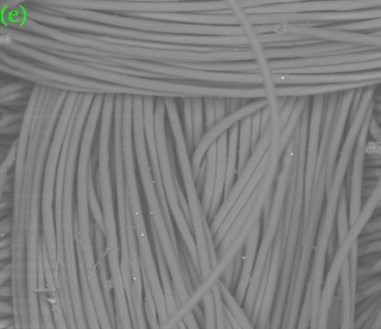HT process for treatment of PET fabrics with chitosan containing recipes
DOI:
https://doi.org/10.25367/cdatp.2023.4.p222-230Keywords:
Polyester fabrics, Finishing, Functional treatment, HT process, Chitosan, SEM, Infrared spectroscopy, NinhydrinAbstract
Polyester is the leading man-made fiber in the field of textiles and clothing. Polyester is usually dyed and finished using a process temperature in the range of 120 to 135 ºC. Such a process is known as a high-temperature (HT) process. The application of chitosan on cellulosic materials is an interesting approach to textile functionalization. In contrast, the application of chitosan by the HT process for the functional treatment of polyester is less investigated. With this background, the present study is related to the surface characteristics of different polyester fabrics with implemented chitosan after performing the HT process.
References
Chakraborty, J.N. Dyeing of polyester. In Fundamentals and Practices in Colourarion of Textiles; Woodhead Publishing India Pvt. Ltd. 2015, pp. 293-307. DOI: 10.1201/b18243-26.
Deopura, B.L., Alagirusami, R., Joshi, M.; Gupta, B. Polyester and Polyamides; Elsevier 2008. DOI: 10.1533/9781845694609.
Choudhury, A. K. R. Chapter 1 – Chemistry of Textile Materials. In Textile Preparation and Dyeing, 2006, pp. 1-39. ISBN: 1-57808-402-4.
Ibrahim, N.A.; Youssef, M.A.; Helal, M.H.; Shaaban, M. F. Exhaust dyeing of polyester-based textiles using high-temperature-alkaline conditions. J. Appl. Polym. Sci. 2003, 89(13), 3563–3573. DOI: 10.1002/app.12573.
Hoque, M.; Mahltig, B. Realisation of polyester fabrics with low transmission for ultraviolet light. Coloration Technology 2020, 136(4), 346-355. DOI: 10.1111/cote.12470.
Natarajan, H.; Haase, H.; Mahltig, B. Polyvinylamine application for functionalization of polyethylene fiber material. J. Tex. Inst. 2017, 108(4), 615-621. DOI: 10.1080/00405000.2016.1177246.
Wardman, R.H. An Introduction to Textile Coloration; John Wiley & Sons Ltd., Hoboken 2018.
Clark, M. Handbook of textile and industrial dyeing; Oxford: Woodhead Publishing 2011. DOI: 10.1533/9780857093974.
Michaels, A.; Vieth, W.; Barrie, J. Solution of gases in polyethylene terephthalate. J. Appl. Phys. 1963, 34, 1-2.
Wang, J.; Mahltig, B. Treatment of Kynol fiber materials – Part 1: dyeing processes. Commun. Dev. Assem. Text. Prod. 2022, 3(1), 17–27. DOI: 10.25367/cdatp.2022.3.
Mahltig, B.; Rabe, M.; Muth, M. Textiles, Dyeing, and Finishing. In Kirk-Othmer Encyclopedia of Chemical Technology, John, Wiley & Sons, Inc. 2019, pp 1–35. DOI: 10.1002/0471238961.0609140903011201.a01.pub2.
Simončič, B.; Tomšič, B. Recent Concepts of Antimicrobial Textile Finishes. In Textile Finishing: Recent Developments and Future Trends; Mittal, K.L.; Bahners, T.; Eds.; Scrivener 2017, pp. 3-48. DOI: 10.1002/9781119426790.
Rath, G.; Hussain, T.; Chauhan, G.; Garg, T.; Goyal, A. Collagen nanofiber containing silver nanoparticles for improved wound-healing applications. J. Drug Target. 2015, 24(6), 520–529. DOI: 10.3109/1061186X.2015.1095922.
Dutta, J.; Tripathi, S.; Dutta, P. K. Progress in antimicrobial activities of chitin, chitosan and its oligosaccharides: a systematic study needs for food applications. Food Sci. Technol. Int. 2012, 18(1), 3–34. DOI: 10.1177/1082013211399195.
Riaz, S.; Munir, A. Recent Advancements in Development of Antimicrobial Textiles. In Advances in Functional Finishing of Textiles, Textile Science and Clothing Technology; Shahid, M.; Adivarekar, R.; Eds.; Springer 2020, pp. 129–216. Available: http://www.springer.com/series/13111 (accessed 2022-07-08). DOI: 10.1007/978-981-15-3669-4.
Antaby, E.; Klinkhammer, K.; Sabantina, L. Electrospinning of Chitosan for Antibacterial Applications – Current Trends. Applied Sciences 2021, 11, 11937. DOI: 10.3390/app112411937.
Ferrero, F.; Periolatto, M. Antimicrobial Finish of Textiles by Chitosan UV-Curing. J. Nanosci. and Nanotechnol. 2012, 12(6), 4803-4810. DOI: 10.1166/jnn.2012.4902.
Choi, C.; Nam, J.-P.; Nah, J.-W. Application of chitosan and chitosan derivatives as biomaterials. J. Ind. Eng. Chem. 2016, 33, 1-10.
Hosseinnejad, M.; Jafari, S. M. Evaluation of different factors affecting antimicrobial properties of chitosan. Int. J. Biol. Macromol. 2016, 85, 467–475. DOI: 10.1016/j.ijbiomac.2016.01.022.
Hu, S.-G.; Jou, C.-H.; Yang, M.-C. Surface Grafting of Polyester Fiber with Chitosan and the Antibacterial Activity of Pathogenic Bacteria. J. Appl. Poly. Sci. 2002, 86, 2977–2983. DOI: 10.1002/app.11261.
Grgac, S. F.; Tarbuk, A.; Dekanic, T.; Sujka, W.; Draczynski, Z. The chitosan implementation into cotton and polyester/cotton blend fabrics. Materials 2020, 13(7), 1616. DOI: 10.3390/ma13071616.

Downloads
Published
How to Cite
Issue
Section
License
Copyright (c) 2023 Mohammad Toufiqul Hoque, Kristina Klinkhammer, Boris Mahltig

This work is licensed under a Creative Commons Attribution-NonCommercial-NoDerivatives 4.0 International License.





